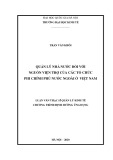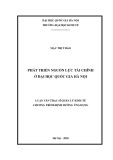
DA NANG UNIVERSITY
UNIVERSITY OF ECONOMICS
THE IMPACT OF EXPORTS ON ECONOMIC GROWTH
OF KHANH HOA PROVINCE
SUMMARY OF Ph.D THESIS
Specialization: Development Economics
Code: 62. 31. 01. 05
Da Nang, 2022

The thesis was completed at
UNIVERSITY OF ECONOMICS, THE UNIVERSITY OF DANANG
Reviewer 1: ......................................................
Reviewer 2: ......................................................
Reviewer 3: ......................................................
The dissertation will be defended at the doctoral defence committee
from University of Economics, The University of Danang
on .................... 202..
The dissertation can be found at:
- National Library of Vietnam
- The University of Da Nang - The Center for Learning Information
Resources and Communication.

1
PREAMBLE
1. Urgency of the topic
Globalization and open integration are inevitable trends in the current open
economic era. The opening and strengthening of trade helps economies to take
advantage of their comparative advantages, improve and enhance their economic
competitiveness, and create a driving force for economic growth. The effects of
international trade on economic growth have been confirmed by economic
theories. This is also a hot topic of discussion among researchers and
policymakers.
These empirical studies are approached in different ways. Among these are
studies that focus on supporting the view of export-led growth. There are also
studies showing that exports affects to the economic structure and promote
economic growth. In another perspective, considering the impact of international
trade in general and exports in particular on poverty reduction. Thus, the empirical
studies mainly select the national economy or the transnational region. Studies
about provincial economy also exist, but not many, and especially with Khanh
Hoa province, there is not yet. A research result on this topic with the economy of
Khanh Hoa will be a test and supplement to enrich this area of research in the
development economics style.
Over the years, Khanh Hoa's GRDP scale has been continuously expanded
thanks to a relatively high and stable growth rate, with the main driving forces
being services and the non-state economic sector, and breadth factors (capital and
labor). Economic restructuring has seen positive changes in the past 10 years.
However, the province's economic growth rate is not commensurate with its
potential and existing strengths; it is slowing down and lacks new impetus. In
addition, the economic position of the province compared to other provinces in
the Middle Coastal Region has a certain decline and the economic structure is still
changing slowly and changing less than that of the provinces in the region. It has
not changed strongly in the direction of restructuring production, restructuring
investment...
In the context of globalization and integration of Vietnam, Khanh Hoa's
economy is also increasingly integrating deeply into the world economy. Khanh
Hoa has had economic relations with many localities of many countries. Khanh
Hoa province's exports scale has been expanded continuously for more than 10
years, the export structure has changed positively. How does such an export
growth affect output growth both directly and spreadly into other fields, especially
exports, and changes in the quality of goods, can change the production structure
of Khanh Hoa? In addition, does exports help improve welfare and reduce poverty

2
here and thereby improve the quality of economic growth. These questions
became more heated when the Khanh Hoa Provincial Government determined to
continue restructuring the economy and renewing the growth model through
restructuring export activities associated with improving productivity and
efficiency. This is a practical question that research on this topic needs to answer.
Exports are still an important factor in Khanh Hoa's economic growth to
fulfill the goal of turning the province into a fairly developed economy in
Vietnam. In order to do this, it is necessary to conduct research on this topic to
draw out export development policy directions to promote economic growth in
Khanh Hoa province quickly and sustainably. This is the policy requirement for
research.
The theoretical, practical, and policy issues that need to be solved have raised
the need for a study on the topic "The impact of exports on economic growth
in Khanh Hoa province.”
2. Research objective
Overall objectives:
The thesis studies the impact of exports on economic growth in Khanh Hoa
province.
Detail goals:
- Firstly, systematizing the theoretical basis of the impact of exports on
economic growth.
- Secondly, giving a complete picture of the GRDP growth and export
performance of Khanh Hoa province with specific light and dark colors.
- Thirdly, analyzing the impact of exports on the economy’s growth of
Khanh Hoa province from the perspective of quality through the angles of
increasing output, restructuring the industry's economy and reducing poverty.
- Fourthly, some policy implications are proposed to promote the expansion
of export activities, thereby promoting economic growth in Khanh Hoa province.
3. Object and scope of research
- Object research: The topic focuses on researching theoretical and practical
issues about the impact of exports on economic growth in Khanh Hoa province.
- Scope of research:
+ About the content: The exports in the study is the exports of goods and
services in the district-level units of Khanh Hoa province. Here also only consider
the growth of export scale mainly. Economic growth in the study is not only an
increase in output, but also considers the structure of the economic sector and
reduces poverty, i.e the thesis considers the quality of economic growth. In
addition, the thesis also only considers the one-way effect from exports to the
economic growth.

3
+ Space: Economy of Khanh Hoa province.
+ Time: Data used in the study from 2010 to 2019, some to 2020. The policy
implications have the significance till 2030.
4. Research Methodology
Research methodology will be explained in the below chapter 2.
5. Scientific significance of the thesis
5.1. Theoretical contributions and main findings
First, the theories of economic growth in Development Economics have been
summarized, thereby drawing out how exports affect economic growth. However,
the empirical studies on this topic in Vietnam and around the world have
differences in the context and scale of the economy. From these works, the thesis
has formed an analytical framework for studying the impact of exports on growth
on the local economy at the provincial level. The fact that there is very little and
no research on this topic at the provincial level and in particular in Khanh Hoa,
the thesis's results are a supplement to enrich the theory of economic development.
This is a contribution of the thesis when it has contributed to fill the "gap" in
theory.
Secondly, the research results have shown the basic bright and dark points
about economic growth of Khanh Hoa province: The scale of the province's
economy in the past 10 years has been continuously expanded thanks to the
relatively high growth rate, stable with the main driving force being services, non-
state economic sector and breadth factors (capital and labor). However, the
province's economic growth rate is not commensurate with the potential and
existing strengths; is slowing down and lacks new impetus, the economic position
of the province compared to other provinces in the coastal zone has a certain
decline. The economic structure has changed quite positively in the past 10 years,
which has contributed to changing the way economic growth is generated.
Thirdly, the research results have made specific assessments of the export
situation associated with the characteristics of Khanh Hoa province. Khanh Hoa
province's export scale has expanded continuously over the past 10 years,
currently accounting for a large proportion compared to GRDP, but the growth
rate is slower than the province's economic growth and is less stable, but its
position in the Vietnam's export turnover is quite modest.
Fourthly, the results of the thesis have confirmed that export has a positive
effect on economic growth: (i) Positive impact from export turnover growth on
production value growth of the economy and exports has a positive spillover
effect on other economic sectors; (ii) Exports also promotes economic
restructuring of the province and is shown in the evidence that the growth of
export turnover reduces the proportion of workers in the agricultural sector and


























